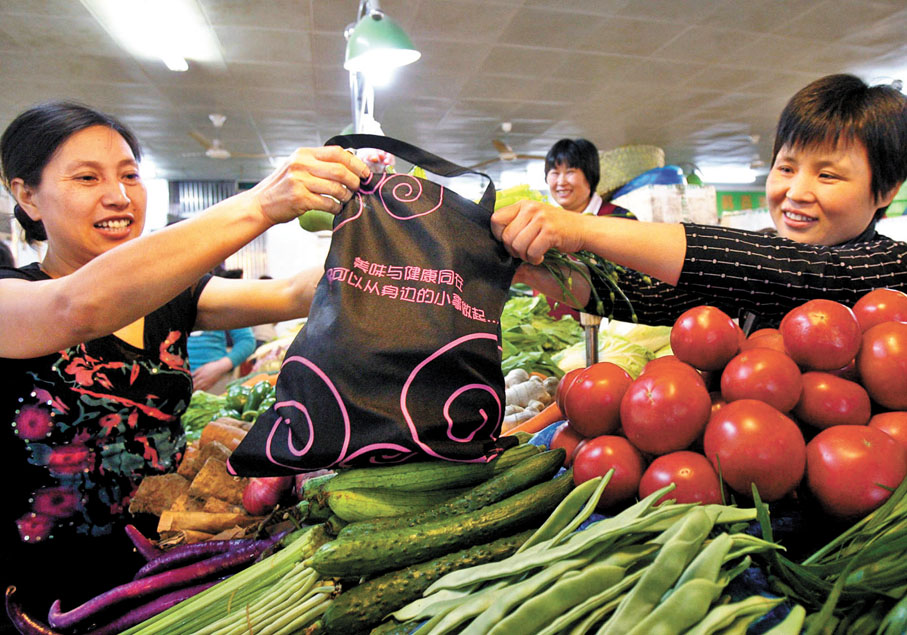
【原文】下文摘錄自2023年1月2日香港《文匯報》︰
眾所周知膠袋是造成環境污染和氣候暖化的元兇之一,故此許多國家均禁用膠袋,又或實施徵費,鼓勵民眾減少使用,部分超市和商店則提供可重複使用的購物袋代替。然而有研究發現,原來這類可重用的購物袋或環保袋,較一次性的即棄膠袋更不環保,要重用最少7,100次,才算得上是真正環保。
據美國有線新聞網絡(CNN)報道,全球各地多年來實施的膠袋禁令,在減少使用即棄膠袋方面可稱得上是成功的,卻衍生出另一個問題,就是消費者大量使用較厚身和較耐用的購物袋,又或是棉質環保袋。零售商也爭相向顧客推銷環保購物袋,聲稱是「即棄膠袋的環保替代品」,結果令不少人的家中都存放了一大堆環保袋,且未必會重複使用。
有環保組織認為,這情況製造了另一個環境問題,指出一個可重用的環保購物袋,碳足跡遠遠高於一個即棄膠袋。
聯合國環境署(UNEP)於2020年進行的一項調查發現,與傳統的即棄膠袋比較,一個以聚丙烯(PP)製造的環保袋必須使用10至20次,才算真正環保;以聚乙烯製造的較薄身環保袋,也要使用5至10次才算環保。
棉質環保袋對環境的影響更嚴重,因其原材料棉花是一種消耗大量資源的農作物,種植時需耗用大量灌溉用水,並使用殺蟲劑和化學肥料,會釋出大量化學元素氮到土地和水道中,形成溫室氣體氮氧化物,意味其碳足跡較許多人所想高得多。UNEP的報告便指出,一個棉質環保袋需使用50至100次,對環境影響才小於一個即棄膠袋。
丹麥環境保護局在2018年進行一項針對膠袋和環保袋的調查,利用氣候變化、臭氧層變薄、空氣污染和用水量等15個環境指標計算,更發現一個棉質環保袋應使用最少7,100次,才能抵消對環境的損害,若是使用有機棉花製造,更需使用2萬次。
有份撰寫UNEP報告的瑞典查爾姆斯理工大學教授埃克沃爾表示,人們經常忘記自己家中已有環保袋,往往會再買一個,「我們應避免這種情況。」
他指出,雖然研究顯示購買即棄紙袋或膠袋,在環保角度上可能較環保袋好,但使用即棄膠袋會助長丟棄文化,應可免則免。
Eco-friendly bags are more damaging to the environment than disposable plastic bags
【譯文】It is well known that plastic bags are one of the culprits of environmental pollution and climate warming, so many countries have banned plastic bags or implemented levies to encourage people to reduce their use. Some supermarkets and stores are offering reusable shopping bags instead. However, a study found that such reusable shopping bags or environmental bags are less environmentally friendly than disposable plastic bags, which must be reused at least 7,100 times before they can be considered truly environmentally friendly.
According to CNN, plastic bag bans implemented worldwide over the years have successfully reduced the use of disposable plastic bags. Still, they have led to another problem: mass use by consumers of thicker and more durable shopping bags or cotton bags. Retailers are also scrambling to sell eco-friendly shopping bags to customers, claiming they are the "eco-friendly alternative to disposable plastic bags," resulting in people keeping piles of eco-friendly bags in their homes and not necessarily reusing them.
Some environmental groups believe that this situation creates another environmental problem, pointing out that the carbon footprint of a reusable green shopping bag is much higher than that of a disposable plastic bag.
A survey conducted by the United Nations Environment Programme (UNEP) in 2020 found that compared with traditional disposable plastic bags, a polypropylene (PP) bag must be used 10 to 20 times to be truly environmentally friendly; a thinner body bag made of polyethylene, but also 5 to 10 times to be environmentally friendly.
The environmental impact of cotton bags is even more severe because its raw material, cotton, is a resource-consuming crop, which requires a lot of irrigation water to grow. Using pesticides and chemical fertilizers will release a lot of chemical elements nitrogen to the land and waterways, forming greenhouse gas nitrogen oxides, meaning that its carbon footprint is much higher than many people think. The UNEP report points out that a cotton bag needs to be used 50 to 100 times before it has less impact on the environment than a disposable plastic bag.
The Danish Environmental Protection Agency surveyed plastic bags and reusable grocery bags in 2018, using 15 environmental indicators such as climate change, ozone layer thinning, air pollution and water consumption, and found that a cotton reusable grocery bag should be used at least 7,100 times to offset the damage to the environment, and if it is made of organic cotton, it needs to be used 20,000 times.
Tomas Ekvall, a professor at the Chalmers University of Technology in Sweden who wrote the UNEP report, said people often forget they have an eco-bag at home and tend to buy another one, "We should avoid this situation." He pointed out that although studies have shown that buying disposable paper or plastic bags may be better than eco-bags from an environmental perspective, using disposable plastic bags contributes to a throwaway culture and should be avoided.◆ 琬琰






0 / 255